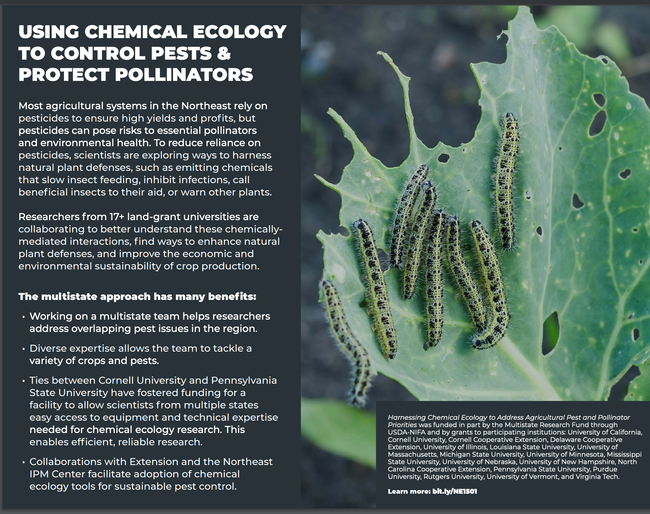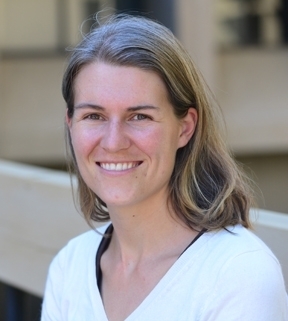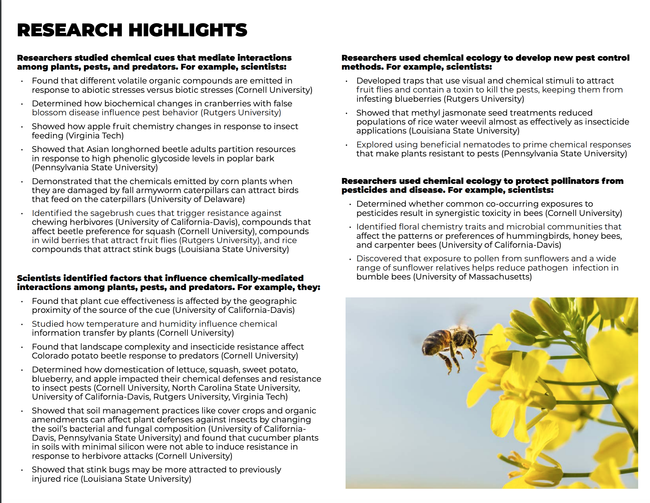
UC Davis is among nine universities singled out for their work in this category. The others are Cornell University, Rutgers University, Virginia Tech, Pennsylvania State University,University of Massachusetts, Louisiana State University, University of Delaware, and North Carolina State University.
Under the category, “Researchers studied chemical cues that mediate interactions among plants, pests, and predators,” UC Davis (Karban) is credited with identifying “the sagebrush cues that trigger resistance against chewing herbivores” and also finding that “plant cue effectiveness is affected by the geographic proximity of the source of the cue.”
Under the category, “Researchers used chemical ecology to protect pollinators from pesticides and disease,” UC Davis (Vannette) is credited with identifying “floral chemistry traits and microbial communities that affect the patterns or preferences of hummingbirds, honey bees, and carpenter bees.”
The Multistate Research Fund supports agricultural innovation and sustainability by providing federal funds to collaborative research projects led by State Agricultural Experiment Stations and land-grant universities. These projects bring together scientists, Extension educators, and other university, federal, and industry partners to tackle high-priority regional or national issues in agriculture, a spokesman said.

Professor Karban, an international authority on plant communication, is the author of the landmark book, Plant Sensing and Communication (University of Chicago Press).
Karban has researched plant communication in sagebrush (Artemisia tridentata) on the east side of the Sierra since 1995. His groundbreaking research on plant communication among kin, published in February 2013 in the Proceedings of the Royal Society B: Biological Sciences, drew international attention. In that study, Karban and his co-researchers found that kin have distinct advantages when it comes to plant communication, just as “the ability of many animals to recognize kin has allowed them to evolve diverse cooperative behaviors.”
“Plants responded more effectively to volatile cues from close relatives than from distant relatives in all four experiments and communication reduced levels of leaf damage experienced over the three growing seasons,” they wrote.
Karban is a fellow of Ecological Society of America and the American Association for the Advancement of Science (AAAS). Michael Pollan featured him in the Dec. 23-30, 2013 edition of The New Yorker: “The Intelligent Plant: Scientists Debate a New Way of Understanding Plants."

Vannette, an assistant professor who joined the UC Davis Department of Entomology andNematology in 2015 and a UC Davis Hellman Fellow in 2018, seeks to unlock the mysteries of flower microbes: how do plants protect against them, and can bees benefit from them?
The Vannette lab is a team of entomologists, microbiologists, chemical ecologists, and community ecologists trying to understand how microbial communities affect plants and insects (sometimes other organisms too). “We often study microbial communities in flowers, on insects or in soil,” according to her website. “We rely on natural history observations, and use techniques from chemical ecology, microbial ecology and community ecology. In some cases, we study applied problems with an immediate application including pathogen control or how to support pollinators. Other questions may not have an immediate application but are nonetheless grounded in theory and will contribute to basic knowledge and conservation (e.g. how can dispersal differences among organisms affect patterns of abundance or biodiversity?).
All plants are colonized by microorganisms that influence plant traits and interactions with other species, including insects that consume or pollinate plants, Vannette explains. “I am interested in the basic and applied aspects of microbial contributions to the interaction between plants and insects. I also use these systems to answer basic ecological questions, such as what mechanisms influence plant biodiversity and trait evolution.”
“Much of the work in my lab focuses on how microorganisms affect plant defense against herbivores and plant attraction to pollinators. For example, we are interested in understanding the microbial drivers of soil health, which can influence plant attractiveness to herbivores and the plant's ability to tolerate or defend against damage by herbivores. In addition, we are working to examine how microorganisms modify flower attractiveness to pollinators. This may have relevance in agricultural systems to improve plant and pollinator health.”
Vannette, a former postdoctoral fellow at Stanford University's biology department, holds a doctorate in ecology and evolutionary biology (2011) from the University of Michigan. Her recent research grants include two from the National Science Federation (NSF). One is a five-year Faculty Early Career Development (CAREER) Program award, titled “Nectar Chemistry and Ecological and Evolutionary Tradeoffs in Plant Adaptation to Microbes and Pollinators.” The other is a three-year collaborative grant, “The Brood Cell Microbiome of Solitary Bees: Origin, Diversity, Function, and Vulnerability.”
Attached Images:
